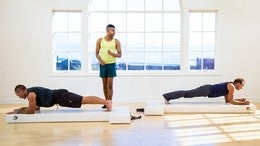Description
About This Video
Transcript
Read Full Transcript
Hi, my name is Brett Howard, and today I'm going to be doing a tutorial on the Teaser. Teaser is actually one of my favorite exercises and I know that it's not a lot of people's favorite exercise, but I wanted to go over it because I felt that it's an exercise that's greatly misunderstood. It's kind of, it gets a bad rap, and just what I'd like to do is do some breakdowns and show how I might progress a client from more basic to advanced. So Teaser, I always like to talk about shapes and space, and talk about different exercises, how there can be like members of a family, you know, cousins to other exercises. So lie down for a second Morin.
I'm working with Morin Bong today, who is actually one of my best friends, and you're gonna bring the arms straight up to the ceiling, and I'm gonna have you just do a simple roll-up. So roll up up to your spine, one vertebrae at a time, and hold here. So right now, she's in a really great C-curve, and this exercise, really if someone can do roll up, someone can do Teaser. It's actually the same exercise. Roll up, the C-curve to roll up, Teaser.
As long as they can do that, I know that the client is actually capable of doing the Teaser. Okay, I'm gonna have you roll down, and knees into the chest. Another sign of readiness, is that if a client can do exercises like rolling like a ball, open leg rocker, I know that they can also do Teaser. So that might be something that I would start with. I would do an exercise like rolling like a ball.
Later on, I would progress to something like open leg rocker, and then I would progress to going to Teaser after that. Once they've mastered rolling like a ball, pretty much mastered open leg rocker, I know they're gonna have a really good chance of doing the Teaser. So, Morin what I'd like to do is I'd like to have you sit up, and we're gonna just take the seal position here. Good, and a C-curve and you're gonna do is you're going to just rock back, and rock up, and we don't even need to do the clapping, just the rolling part of it, and again rock back, and rock up and hold here. Good, so hold this position.
What you're gonna do is you're going to maintain the shape of your pelvis, and you're going to do something what I say, not get fresh. So I don't want you doing any sort of rated R type of things. So you're gonna bring the hands to back of your thighs. You're going to maintain your C-curve. Then from there you're going to extend the legs, and then if I walk up, I'm in my open leg rocker position.
Then from there if I bring my legs together, reach, I'm in my Teaser position. I can bend my knees. I'm in my rolling like a ball position. So they're all cousins to one another. Okay, so another thing I like to talk about with Teaser, is that knowing the correct shape.
A lot of times, people feel that they cannot do it, but if they just change maybe one-inch forward or back, where their back and pelvic alignment is, it's a lot more doable. You know, a lot of times when people do Teaser, they have this image of what it should look like, and you see people on covers of magazines and cover of books, doing this beautiful Teaser, and actually I would say, I'm on the cover of a book doing a Teaser, but guess what, I didn't roll up into it. When it's time to take the picture for the book, I brought my knees in and smiled. Right, so I didn't roll up. If I would have have rolled up into it, it probably would have looked a lot different than the actual picture did.
So I want you to just take your open leg rocker position. Great. Now what you're going to do is you're going to curve in the lower back. Good, I'm gonna keep you with the open leg rocker, and I'm gonna just take the Teaser position. Good, now hold that, two, three, now flatten your back.
This is a lot of people like to do, they like to flatten their back and it goes (makes scraping noises). Alright, now curve your spine, and then it goes back into your abdominals. Now flatten your back and make a really dramatic flat back, (makes scraping noises) curve, the back and here again it's in the abdominals. I can stay here forever. You can stay there forever.
I could have some tea if I want as well. Alright, so you can rest. So just knowing that it doesn't have to be this super-flat position. You can maintain a C-curve in the lower back and then that's gonna help it be a little bit more manageable. So lie down.
First thing that I like to do is I like to start with something what we call the assisted Teaser. And this is something that I learned from Ramana. Bring the knees into the chest. Then I would give them either a dowel or a weighted dowel. The weighted one will give a little bit more, give the client a little bit more help.
You're gonna bring the legs out to me, and then what Ramana would do, is she'd anchor them onto her thighs here. If sometimes, you know, Ramana was shorter than me, I'm taller, she would actually bring it into her hip fold. I'm gonna go here because a little bit more comfortable for me, and I'm gonna act as if you cannot roll up. So roll up, and just come up a little bit and hold there. Maybe that's the hump that the client cannot get over so then I can just lean back and help them come up a little bit to there.
Then on the way down, Ramana would say, "Pull me down. "Pull me down. "Pull me down." So it helps to open up the back, get a little work in the abdominals. Bring the arms back overhead. We'll do that one more time, rolling up, and then if she needs the help, I can lean back a little bit to help her then pull me down.
Pull me down from this sacrum lower back, middle back, upper back, exactly. So that is what we call the pull. Now sometimes we did a push. So roll up and pretend like you can't come up, and then bring arms just a little higher. Now push me away.
Push, and I'm giving her a little bit of pressure, as she is giving me pressure. Now on the way down, I'm gonna push you. You're gonna push me a little bit, and then that helps you in a different way. So some people are more pullers. Some people are more pushers.
It really depends, you know. Not every key unlocks every door. So you have to really find out the appropriate key. So the appropriate exercise for that person. Alright, let's try that one more time.
So we're rolling up, and I give her a little push. She pushes me away, and then I push her. She gives me a slight push, but allows that lower back to roll down, and that's what we call the assisted Teaser. So both knees into the chest. That might be the first step, or the first skill that I would like the client to master.
Then as I start to layer on, I want them to learn how to roll up unassisted. So, what I do is I call this the modified Teaser. I'll do it with you. I'm gonna start lying down. You're going to roll the head, neck and shoulders up, as you reach the arms forward.
Then from there extend the legs straight up to the ceiling. Hold onto the back of the thighs. Now like a seesaw, you're just gonna rock up, come to a rounded position. Good so she didn't get fresh. Then from there you're gonna extend the leg so that you pull back through your navel and ribs.
Then try to find your balance and hold, two, three, now roll down. When you have to, you can bend the knees, and you can relax. So that would be step one. Over time, and it's not going to be the same day, it might be days later or weeks later, and I would add on this next step. So hands forward, chin forward, legs straight up to the ceiling.
Now instead of holding onto the back of the thighs, like a seesaw, simultaneously, you're gonna drop the feet, bend the knees, roll up into your nice rounded position. Then from there you can extend the legs and hold. Then bring the arms parallel to the legs, hold. Then from there roll down to your spine, one vertebrae at a time, knees into the chest, and then you can relax. So that would be the next step.
Third step, once I see that they have mastered that skill, is to roll the head, neck and shoulders up, both legs up, not using the hands, simultaneously, bend the knees, roll up as you drop the feet. Left the legs for three, two, one. Bring the arms parallel two, three. Now, keep the ribcage, no Mary Lou Retton. You're gonna bring the arms up to the ears, then from there, we're gonna roll down to your spine, pushing back with the hands, knees in, and you can relax.
So, it's something that could be done over time. I wouldn't do it all in one session, possibly, depending on the client that I'm working with, but it's a way to build on top of skill, build on top of skill, build on top of skill. Alright, how are you doing? Good. Good.
So those are all preparatory exercises, so I don't have to do the assisted one and then go to the modified. I can, you know, pick and choose of how I want to work with the client. Another exercise that I like to do with someone, would be Kathy Grands, rolling into Teaser. This is also just to show that Teaser's not so hard, you know, just as long as you get into the right positioning. So, I'm gonna have you start seated.
You're gonna grab ahold of your oars, then from there, you're going to start with the tailbone. You're gonna curl the lower back down, and it's really good to try to get as much of your sacrum on the mat as possible. Now hold there, find a deep C-curve. Now open the arms. Now it's important to stay on one plane, not to allow your arms to go down.
On that plane, just go back, back, back, back. At a certain time the legs get light, and look the legs just pop up. It's called physics. And then ease into the chest and sitting up. Some people think it's magic.
It's not magic. It's physics. Alright so start with the tailbone. You're gonna curl under. Try to get as much of your lower back on the mat as possible.
Open the arms on this plane. You're gonna bring the arms back, back, back and look up, just pops right up. Not magic, physics! Now hold there. You're going to the next step. Roll down, half way, and then roll back up.
Roll half way down, roll back up, one more time. Half way down, roll back up, all the way down, knees into the chest, and rest the head. So that's a variation that I've tagged on to it. It would be a next step. Sometimes when you're working with Ramana, she wouldn't start you from the down position.
She would start you from the up position. She'd have you curl, left the legs, then find the Teaser, and you'd roll half way down, half way up, and that's tagging two different exercises, rowing into Teaser from Kathy, with the Ramana half position. Once I see that they can consistently find that position then I would start to go into Teaser one. First, assisted without a bar, knees into the chest. Arms are gonna go next to the ears.
Legs out to me. Very good, and then you're gonna start with the tail, with the crown of the head, you're gonna roll up, find that Teaser. Now hold there. I'm gonna grab here. You grab my wrist, pull back through your ribcage a little.
There. Now from here left your sternum a little bit, without losing the ribs. Good now I'm gonna take my hand away. Good, and roll down to your spine. Alright, knees into the chest, relax.
I would do that about three times. Then I would give them less pressure, less help. Arms next to the ears, legs are gonna go out to me, and rolling up. Good, now hold there, keep the ribs, lift the arms up, and then start with the tailbone, roll down to your spine. Then I'm gonna play a operation.
Don't touch my hands. Roll up and if she touches I go, buzz, buzz. Arms to ears. Childhood game, most people know that one. And roll down.
Last time, so you're giving them a goal. Roll up, whoop, that was more like a throw up, than a roll up (laughs). Now roll down through your spine, knees into the chest (laughs) and hug the legs. Okay, let's move on to Teaser two. Arms are gonna go next to the ears.
Legs out. Once I see they can roll up. Roll up, hold there. Press down on my hands, and then you're going to lower the legs to where you can control. Lift the legs up.
Lower to your control. Lift the legs up, lower to your control. Lift the legs up, and then arms to ears, roll down to your spine, knees into the chest and hug. So Teaser one, I'm focusing on keeping the upper body mobile, lower body stable. Teaser two, I'm reversing it.
Upper body's stable, lower body can be mobile. Upper body half, lower body half. Teaser three, I can put the two together. So legs out onto the mat. Arms are gonna go straight to the ears.
Now I always think of a slightly deflated pool raft, and I know that's a weird image, but, you know you can relax for a second (laughs). But I always remember being younger and you know, walking by the pool and you know you accidentally step on the slightly deflated pool raft that's been sitting there for like a month, and it goes (whooshes) and just folds right up. So where you step, you step right in the middle. From there everything should just fold up. So arms are gonna go next to the ears.
Now what I'm gonna have you do is simultaneously, and simultaneously is the operative word there. Simultaneously, you're gonna lift your head and your feet, and then roll up to Teaser. Beautiful, now, no Mary Lou Retton, so none of this, you're gonna lift the arms up without those ribs going. Beautiful, simultaneously, roll down, allowing the head and the heels to arrive at the same time. Simultaneously, someone steps right here, and you fold, oh, oh, uh, I'm not sure if that's simultaneous (laughs).
Let's try that again (laughs). So stop right there, head and feet simultaneously. That was better. Now don't let the ribs go as you lift the arms up. Simultaneously, rolling down through your spine.
Beautiful. Alright, over time I can tag this all together as I can go into Teaser one, Teaser two, Teaser three. And then over time, I can also add in Teasers. So when I work with Ramana, we actually had eight different Teasers. I'm not gonna do all of that because I think these three are good enough to go for the majority of your clientele.
So, let's go into Teaser one. Arms next to ears, legs out, roll up into Teaser. Now, maintain the stability of the lower body half, arms to ears, upper body rolls down one vertebrae at a time. Second time rolling up, lift the arms to ears. Roll the spine all the way down.
Last time, rolling up. This time hold right there. Keep that C-curve, lower the legs, lift. Nothing in the upper body moves as you lower the legs. Lift, lower the legs, lift hold there.
Teaser three, arms to ears. Everything floats down simultaneously. Now, simultaneously everything floats up, reaching towards the toes, arms to ears, float down, one vertebrae at a time, and float up, rolling up arms to ears. Good, and float down, simultaneously arriving, good. And knees into the chest, hug the legs.
Very good, and so that's the Teaser. So Teaser is not an exercise that's not, you know, that's not attainable. It's actually a very attainable exercise. A lot of times we just have to find the right positioning. Trying not have the weight too far forward on the (faint speaking) bones having it be a little further back, making sure you don't lose the pelvic ribcage integration.
You know, I would say it's like tying a knot. If you're gonna reach away from your center, you think of a knot, you pull the knot, you pull the two ends of the string away, the knot gets tighter as you pull away from that. And so that's what you have to think about with Teaser. You know, as you move away from the midline, it's going to focus more into the core. Thanks.
And that's the Teaser!
Comments
You need to be a subscriber to post a comment.
Please Log In or Create an Account to start your free trial.


































